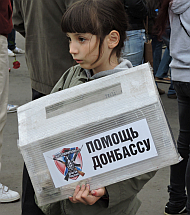Klaus Hart Brasilientexte
Aktuelle Berichte aus Brasilien – Politik, Kultur und Naturschutz
„Children and Consumerism“ – Befreiungstheologe Frei Betto
The Second International Forum on Children and Consumerism will take place in Sáo Paulo from September 23 to 25 2008 in the Itau Cultural Institute. During three study evenings children™s consumerism and its consequences will be discussed.
On the first evening there will be the launching of the documentary ”Children and Consumerism. On the following evenings there will be debates on ”Advertising, Education and Childhood (24/9) and ”The Consumer Society (25/9).
Finally on the last evening the Alana Institute™s video of pedagogical activities developed with children from the project ”Educando na periferia (Educating in the shanty towns) will be shown. In this video a group of children react to the question ”What would life without advertising be like?“.
On September 22 there will be a workshop exclusively for journalists. The aim is to pass on to them the basics and arguments regarding the subject of consumerism, the new ways to focus on the theme and to show them various ways, as journalists, to cover the subject. Â
Children are not easily attracted to the consumer market; they are full of imagination and creativity and are capable of making a horse out of a broomstick or a castle from a bucket of sand. However according to the logic of the market, children as consumers have two advantages, they have no discernment and they can seduce adults. I got to the age of thirteen before the money factor entered my life. I don™t recall what brand of tennis shoes I wore. The most I ever did was to ask my father to bring me a box of nails when he returned from work in order to put my go-cart together.
How does one turn a child into a consumer? A very common recourse is precocious eroticization. One has only to look at the clothing worn by children™s TV program presenters in Brazil. When a child starts putting on makeup in front of a mirror at 4 or 5 years of age, pays too much attention to his or her own body, becomes interested in the brand names of tennis shoes or clothes¦ Â that precociously eroticized child will show adult facial expressions, use adult vocabulary, have adult desires. The child is psychologically ”adult and biologically a child.
On reaching puberty the body awakens and the conscience moves from fantasy to reality “ then, insecure, the child tries to prolong the fantasy. Thus he or she becomes vulnerable to drugs. Drugs fulfill the roll of prolonging the fantasy in immature adolescents who have been ˜educated™ to be precocious consumers.
A remarkable phenomenon of neo liberalism is that formerly, when one wore a shirt, one valued the cloth, thus humanising the cloth by wearing it. Today on the contrary, it is the shirt with its brand name which gives value to the person. The value increases according to how many brand names the person wears. If the person arrives somewhere on foot, his value is Z, if he or she arrives in a BMW, he or she rates an A! The merchandise used by the person increases or decreases his or her value. This is the reification of the human being.
In order to avoid such distortions the Alana Institute in 2006 created the project ”Children and Consumerism which seeks to foster a critical conscience regarding the consumption of products and services by children and adolescents in order to avoid, as much as possible, the mercantilism of childhood and youth, the culture of violence, excessive materialism, the erosion of social relations, etc.
Alana investigates advertising directed to children and youth, collects denunciations and takes legal measures together with relevant organisations to stop advertisements which do not educate young people.
There are many examples on TV: at the beach “ a group of young girls sigh when they see a handsome adult wearing coloured flip flops (precocious eroticization), two children under 10 hypnotise their mother so that she will shop in a particular store (inversion of values), a puppy pushes, with its nose, a child on a swing (exploiting of childish gullibility and a security risk), gifts associated with the purchase of sweets (stimulating of excessive consumption of foods), children in a car kept quiet by the DVD player placed behind the front seats (undermining the educational role of the family and over valuing technology).
Children should not be the objects of advertising. Â In order to become healthy adults they need affection, self esteem, respect (conscience regarding boundaries) and plunging into their own world of dreams.
For more information: Â www.alana.org.br <http://www.alana.org.br>
*Frei Betto is a writer, co-author with his mother Maria Stella Libanio Christo, of ”Fogáozinho, culinária em histórias infantis (The little stove, children™s cooking stories) (Mercuryo Jovem).
« Große Erfolge bei geförderter Entpolitisierung und Kulturverlust auch in Deutschland. – Brasilianische Mentalität: Nur drei Prozent der Brasilianer halten für möglich, in Mitmenschen zu vertrauen, sagt neue Studie. Vertrauen in Freunde begrenzt. Enormes Mißtrauen unter „Kollegen“. Kultur der Scheinheiligkeit. „Unehrlichkeit ist Kultur.“(Joao Ubaldo Ribeiro) Depression, Gruppendruck, Zwangsgrinsen.“In einer Kultur wie der unseren, in der die Scheinheiligkeit mit Sicherheit die herrschende Moral ist, deklariert man nie die wahren Absichten.“ O Estado de Sao Paulo »
Keine Kommentare
Noch keine Kommentare
Die Kommentarfunktion ist zur Zeit leider deaktiviert.
NEU: Fotoserie Gesichter Brasiliens
Links zum Thema Ukraine
Fotostrecken Wasserfälle Iguacu und Karneval 2008
interessante Links
Seiten
Ressorts
- Kultur (6.975)
- Naturschutz (1.101)
- Politik (12.729)
Suchen
RSS-Feeds
Verwaltung


